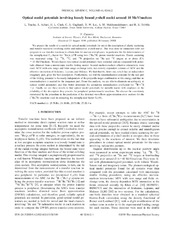| dc.creator | Trache, L. | |
| dc.creator | Azhari, A. | |
| dc.creator | Clark, HL | |
| dc.creator | Gagliardi, Carl A. | |
| dc.creator | Lui, YW | |
| dc.creator | Mukhamedzhanov, AM | |
| dc.creator | Tribble, Robert E. | |
| dc.creator | Carstoiu, F. | |
| dc.date.accessioned | 2011-09-13T21:26:54Z | |
| dc.date.available | 2011-09-13T21:26:54Z | |
| dc.date.issued | 2000 | |
| dc.identifier.citation | L. Trache, A. Azhari, H. L. Clark, Carl A. Gagliardi, Y. W. Lui, A. M. Mukhamedzhanov, Robert E. Tribble and F. Carstoiu. Phys.Rev.C 61 024612 2000. "Copyright (2000) by the American Physical Society." | en |
| dc.identifier.uri | http://dx.doi.org/10.1103/PhysRevC.61.024612 | |
| dc.identifier.uri | https://hdl.handle.net/1969.1/126894 | |
| dc.description | Journals published by the American Physical Society can be found at http://publish.aps.org/ | en |
| dc.description.abstract | We present the results of a search for optical model potentials for use in the description of elastic scattering and transfer reactions involving stable and radioactive p-shell nuclei. This was done in connection with our program to use transfer reactions to obtain data for nuclear astrophysics, in particular for the determination of the astrophysical S-17 factor for Be-7(p, gamma)B-8 using two (Be-7,B-8) proton transfer reactions. Elastic scattering was measured using Li-7, B-10, C-13 and N-14 projectiles on Be-9 and C-13 targets at or about E/A = 10 MeV/nucleon. Woods-Saxon type optical model potentials were extracted and are compared with potentials obtained from a microscopic double folding model. Several nucleon-nucleon effective interactions were used: M3Y with zero range and finite range exchange term, two density dependent versions of M3Y and the effective interaction of Jeukenne, Lejeune, and Mahaux. We find that the latter one, which has an independent imaginary part, gives the best description. Furthermore, we find the renormalization constant for the real part of the folding potential to be nearly independent of the projectile-target combination at this energy and that no renormalization is needed for the imaginary part. From this analysis, we are able to eliminate an ambiguity in optical model parameters and thus better determine the asymptotic normalization coefficient for B-10-->B-9 +p. Finally we use these results to find optical model potentials for unstable nuclei with emphasis on the reliability of the description they provide for peripheral proton transfer reactions. We discuss the uncertainty introduced by the procedure in the prediction of the distorted wave Born approximation cross sections for the (Be-7,B-8) reactions used in extracting the astrophysical factor S-17(0). | en |
| dc.language.iso | en | |
| dc.publisher | American Physical Society | |
| dc.subject | ASYMPTOTIC NORMALIZATION COEFFICIENTS | en |
| dc.subject | INTERACTION CROSS-SECTIONS | en |
| dc.subject | ALPHA-PARTICLE SCATTERING | en |
| dc.subject | LI-6 ELASTIC-SCATTERING | en |
| dc.subject | BE-7(P,GAMMA)B-8 | en |
| dc.subject | REACTION | en |
| dc.subject | BE-7(D,N)B-8 REACTION | en |
| dc.subject | ANGULAR-DISTRIBUTION | en |
| dc.subject | S-17(0) FACTOR | en |
| dc.subject | HALO NUCLEI | en |
| dc.subject | RADII | en |
| dc.subject | Physics | en |
| dc.title | Optical model potentials involving loosely bound p-shell nuclei around 10 MeV/nucleon | en |
| dc.type | Article | en |
| local.department | Physics and Astronomy | en |


